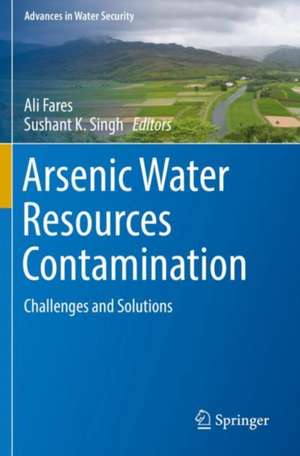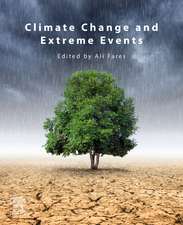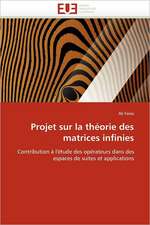Arsenic Water Resources Contamination: Challenges and Solutions: Advances in Water Security
Editat de Ali Fares, Sushant K. Singhen Limba Engleză Paperback – 15 aug 2020
Part one of the book describes the issue of arsenic contamination in ground water and river basins, including its source and distribution in specific locations in India. Part two explains the routes of exposure to environmental arsenic, its transport in aquatic ecosystems, and the health risks linked to arsenic exposure in food and the environment. Part three addresses sustainable arsenic contamination mitigation strategies and policies, the socioeconomic, demographic, cultural and psychological aspects of arsenic contamination, and the potential applications of GIS and remote sensing in providing solutions. Part four concludes by discussing the role of local and regional institutions in water resources management for a variety of issues including but not limited to arsenic contamination, and presents a case study in the Indus river basin in Pakistan to propose future contamination mitigation strategies.
| Toate formatele și edițiile | Preț | Express |
|---|---|---|
| Paperback (1) | 684.80 lei 38-44 zile | |
| Springer International Publishing – 15 aug 2020 | 684.80 lei 38-44 zile | |
| Hardback (1) | 696.58 lei 38-44 zile | |
| Springer International Publishing – 15 iul 2019 | 696.58 lei 38-44 zile |
Preț: 684.80 lei
Preț vechi: 901.05 lei
-24% Nou
Puncte Express: 1027
Preț estimativ în valută:
131.08€ • 142.43$ • 110.18£
131.08€ • 142.43$ • 110.18£
Carte tipărită la comandă
Livrare economică 17-23 aprilie
Preluare comenzi: 021 569.72.76
Specificații
ISBN-13: 9783030212605
ISBN-10: 3030212602
Pagini: 305
Ilustrații: VIII, 305 p. 59 illus., 53 illus. in color.
Dimensiuni: 155 x 235 mm
Ediția:1st ed. 2020
Editura: Springer International Publishing
Colecția Springer
Seria Advances in Water Security
Locul publicării:Cham, Switzerland
ISBN-10: 3030212602
Pagini: 305
Ilustrații: VIII, 305 p. 59 illus., 53 illus. in color.
Dimensiuni: 155 x 235 mm
Ediția:1st ed. 2020
Editura: Springer International Publishing
Colecția Springer
Seria Advances in Water Security
Locul publicării:Cham, Switzerland
Cuprins
Chapter1: Groundwater arsenic contamination and availability of safe water for drinking in Middle Ganga Plain in India.- Chapter2: Geomorphic controls on spatial arsenic distribution in aquifers of the Brahmaputra River floodplains.- Chapter3: Reductive dissolution of Fe-oxyhydroxides a potential mechanism for arsenic release into groundwater in the alluvial plain of river Brahmaputra.- Chapter4: Sources of arsenic exposure in well-nourished children.- Chapter5: Environmental arsenic exposure and human health risk.- Chapter6: Sustainable arsenic mitigation: problems and prospects in India.- Chapter7: Arsenic Contamination of Soil in Relation to Water in Northeastern South Africa.- Chapter8: Arsenic contamination of India’s groundwater: a review and critical analysis.- Chapter9: Biosorption of Arsenic: An Emerging Eco-technology of Arsenic Detoxification in Drinking Water.- Chapter10: Assessing and mapping human health risks due to arsenic and socioeconomic correlates for proactive arsenic mitigation.- Chapter11: Arsenic-contaminated drinking water and the associated health effects in the Shahpur block of Bihar: a case study from five villages.- Chapter12: Arsenic contamination of drinking water and mitigation in Pakistan: a case of Indus river basin.
Notă biografică
Ali Fares is the Interim Vice President of Research, Innovation, and Sponsored Programs and Professor of Water Security at Prairie View A&M University, Texas. He is currently the editor of the Water Security Book Series and edited two books. In addition, he published 14 book chapters, over 20 conference proceedings, and over 74 articles in peer reviewed journals. His research interests include disaster preparedness and resiliency, flood prediction and mitigation, water security, water-energy-food nexus, watershed hydrology and management, water allocation, irrigation management, and adaptation and mitigation of climate variability.
Dr. Sushant Singh is the lead artificial intelligence and machine learning scientist in the Department of Health, Insurance and Life Sciences at Virtusa Corporation, New York. He earned two PhD degrees: one in Environmental Science from India and another in Environmental Management in the US. He authored more than 30 peer reviewed journal articles, two books, three book chapters, two conference proceedings, one encyclopedia entry, and over 25 international presentations. His research interests include the application of artificial intelligence in health, insurance, life sciences, and environmental sustainability.
Textul de pe ultima copertă
This edited volume brings together a diverse group of environmental science, sustainability and health researchers to address the challenges posed by global mass poisoning caused by arsenic water contamination. The book sheds light on this global environmental issue, and proposes solutions to aquatic contamination through a multi-disciplinary lens and case studies from Bangladesh and India. The book may serve as a reference to environment and sustainability researchers, students and policy makers.
Part one of the book describes the issue of arsenic contamination in ground water and river basins, including its source and distribution in specific locations in India. Part two explains the routes of exposure to environmental arsenic, its transport in aquatic ecosystems, and the health risks linked to arsenic exposure in food and the environment. Part three addresses sustainable arsenic contamination mitigation strategies and policies, the socioeconomic, demographic, cultural and psychological aspects of arsenic contamination, and the potential applications of GIS and remote sensing in providing solutions. Part four concludes by discussing the role of local and regional institutions in water resources management for a variety of issues including but not limited to arsenic contamination, and presents a case study in the Indus river basin in Pakistan to propose future contamination mitigation strategies.
Caracteristici
Addresses the challenges posed by global mass poisoning from arsenic water contamination Synthesizes research in environmental sciences, management, sustainability, public health and policy Presents case studies in Pakistan and India to discuss prediction models and policy recommendations for mitigating arsenic contamination

















